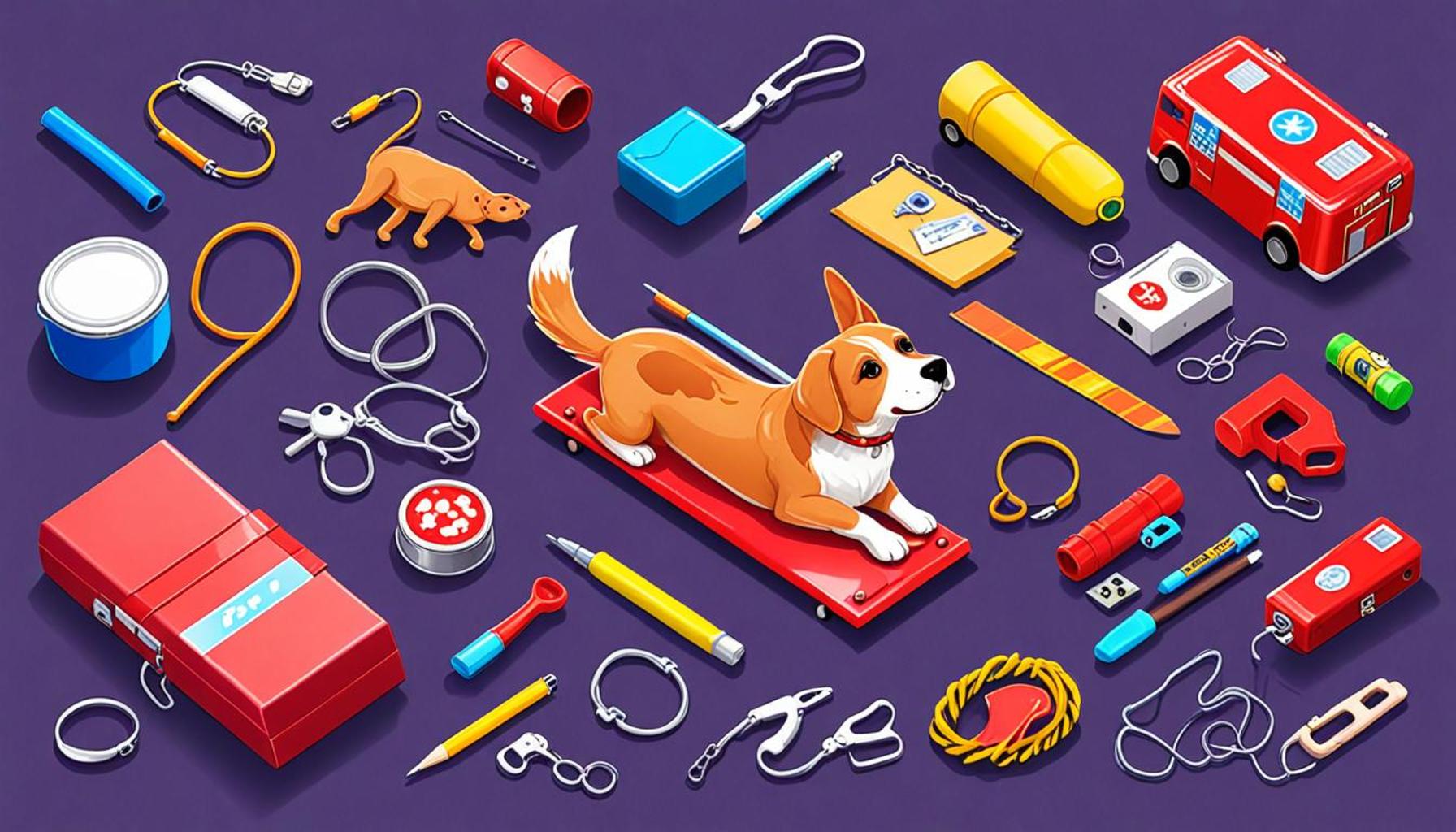Pet Training for Emergency Situations

Understanding pet training for emergency scenarios
In a world filled with unpredictability, ensuring your pet’s safety is essential. Emergency situations can arise at any moment, and a well-trained pet can make a significant difference. From natural disasters to sudden health emergencies, being prepared empowers both you and your furry friend. Regular training can not only boost your pet’s safety but can also significantly enhance your peace of mind.
Why Train Your Pet for Emergencies?
Training your pet for emergency situations is not just about basic commands; it’s about fostering a responsive relationship that can withstand stress and chaos. The importance of this type of training can be illustrated through various aspects:
- Enhanced Safety: A trained pet can help avoid dangerous situations. For example, if there’s a sudden loud noise, such as thunder or fireworks, a well-trained dog familiar with the ‘place’ command will know to find a quiet spot instead of bolting outside.
- Improved Communication: Clear commands can calm your pet in stressful situations. During a crisis like a fire, being able to quickly instruct your pet can make the escape smoother and faster. For instance, teaching your pet to come when called can be life-saving during an emergency evacuation.
- Greater Confidence: Knowing your pet can respond appropriately reduces anxiety for both you and your furry companion. A dog accustomed to basic recall commands and leash manners will be far less likely to panic and wander off when faced with unexpected circumstances.
Types of Emergencies to Prepare For
It’s crucial to consider the various types of emergencies where training can be beneficial:
- Natural Disasters: Events like earthquakes, floods, or hurricanes can displace families, making it essential to have a pet that can follow commands promptly. In a region prone to hurricanes, including your pets in your emergency plan can save their lives.
- Fire Hazards: Quick and effective escape plans are crucial when it comes to fire safety. Training your dog to respond to a fire alarm can ensure you both make it out safely. Practice fire drills that include your pets to create familiarity.
- Medical Emergencies: Training can prove invaluable if your pet experiences a sudden health issue, such as a seizure or choking. Being able to effectively guide your pet to a nearby veterinarian or teach them to remain calm can assist greatly in critical situations.
By investing time and effort into training your pet, you create not only a more responsive companion but also an unbreakable bond between you. Consider enrolling your pet in classes that focus on emergency preparedness or contact a local trainer who specializes in this area. As you learn together, you’ll discover more strategies to prepare your pet effectively in the face of uncertainty, ensuring both you and your furry friend remain safe and sound through life’s unpredictable moments.
DISCOVER MORE: Click here to learn about the best nutrition for your pet
Essential Training Techniques for Emergencies
Training your pet for emergency situations involves a series of specific techniques that cultivate a responsive and composed companion. These techniques are designed to address not only basic behaviors but also commands that can become vital during high-stress moments. Understanding and implementing these training methods can be invaluable when it matters most.
Key Training Commands to Teach Your Pet
In emergency scenarios, certain commands can make all the difference. Here are some critical commands that every pet owner should consider integrating into their training regimen:
- “Come” Command: This is perhaps the most crucial command to master. Teaching your pet to come immediately when called can be lifesaving during emergency evacuations. Start in a quiet environment to help your pet associate the command with positive reinforcement, gradually increasing distractions as their skills develop.
- “Stay” Command: The ability to remain in one spot can prevent chaos during emergencies. Use this command during practice sessions, placing your pet in a safe space and gradually increasing the duration they must stay put. This helps build patience and trust, essential in times of crisis.
- “Heel” Command: Training your pet to walk obediently beside you on a leash is essential during evacuations or crowded situations. This command teaches your pet to focus on you, providing control and safety while moving to a secure location.
- “Go to Your Place” Command: Teaching your dog a designated safe spot, such as a bed or crate, can greatly reduce anxiety during emergencies. Practicing this command can help your pet feel secure amid panic and loud noises, allowing you to handle the situation more effectively.
Incorporating Realistic Training Scenarios
Regular training sessions should also include realistic scenarios that mimic emergency situations. Families can set up practice drills and simulate conditions that may occur during a crisis:
- Fire Drill Practice: Plan a smoke alarm drill that includes your pets. Help them understand the importance of responding calmly to alarming noises and following you quickly to safety.
- Outdoor Evacuation Routes: Familiarize your pets with various routes to designated safe locations. Take them on walks to rehearsal locations and teach them to follow your lead, ensuring they understand that these routes are safe during emergencies.
- Handling Loud Noises: Gradually expose your pet to loud noises in controlled environments, such as with a recorded fire alarm, followed by rewards and praise for remaining calm. Desensitizing your pet to shocking sounds can mitigate panic during real situations.
Ultimately, the goal is to create a pet that is not just responsive but also confident and composed in emergencies. Training requires consistency and patience, but the benefits are immeasurable. With well-defined commands and practiced scenarios, you empower your pet to navigate unpredictable situations alongside you, reinforcing the bond you share with your furry friend. As you commit to this training journey, keep in mind that every small improvement enhances both your pet’s safety and your peace of mind.
| Advantage | Description |
|---|---|
| Increased Safety | Training your pet for emergency situations can save their life and yours, fostering a safe environment. |
| Enhanced Confidence | A well-trained pet remains calm during crises, making them easier to manage in stressful scenarios. |
Effective pet training for emergency situations equips your furry friend with the necessary skills to respond appropriately during unforeseen events. By focusing on practical techniques, such as teaching your pet to come when called or stay still, you are ensuring their safety in potentially dangerous circumstances. Moreover, with proper training in sudden incidents like natural disasters or medical emergencies, pets can dramatically reduce their risk of injury or chaos.Moreover, trained pets exhibit higher levels of confidence and stability when faced with pressure, making them less likely to act out of fear. Engaging in regular training sessions not only bolsters your pet’s skills but also strengthens your bond, ultimately contributing to better companionship. As you explore various training methodologies, it’s essential to consider the unique behaviors and responses of your pet to tailor a training plan that suits them.
DISCOVER MORE: Click here to learn about balanced nutrition for pet health
Long-term Strategies for Effective Emergency Training
While immediate commands are essential, developing a long-term strategy for emergency training ensures that your pet remains prepared, resilient, and adaptive under pressure. Instilling a routine within your pet’s training can foster familiarity and ease during chaotic moments. Here are several strategies to help reinforce emergency preparedness over time:
Consistent Socialization
Socialization is a cornerstone of well-rounded pet training. Regularly exposing your pet to new environments, people, and other animals can mitigate stress during emergencies. Practicing in varied settings, such as parks, pet-friendly stores, or crowded outdoor events, helps your pet grow accustomed to different stimuli. This kind of exposure reduces anxiety and increases responsiveness when quick action is needed.
Utilizing Positive Reinforcement
Utilizing positive reinforcement remains one of the most effective training methods for pets. Rewarding your pet with treats, affection, or playtime when they successfully follow commands during training sessions not only helps solidify the desired behavior but also creates positive associations during stressful events. This technique motivates your pet to listen and respond appropriately, crafting a trusting relationship between you and your companion.
Regular Assessment and Refreshing Training
Consistency is key, but it’s equally important to assess your pet’s skills periodically. Regular assessments can help you identify areas that may require additional focus. Incorporating surprise drills into your training routine mimics real emergency conditions. This helps your pet stay sharp and responsive, maintaining their skills over time. Additionally, refresh training for forgotten commands ensures that your pet is always ready to react in an emergency.
Building a Comfort Kit
Creating an emergency comfort kit can be a proactive way of preparing for unforeseen situations while helping your pet feel secure. This kit should include items such as their favorite toys, familiar blankets, and a supply of their preferred treats. Familiar objects can help provide comfort and a sense of safety if they need to evacuate or experience new surroundings. Tailoring the kit to your specific pet’s needs can improve their resilience during crises, making them easier to manage.
Engaging in Community Preparedness Initiatives
Participating in local community safety events can also enhance your pet training experience. Many organizations offer pet-specific training sessions addressing emergency protocols, enabling owners to learn alongside their pets. Additionally, these initiatives often provide valuable resources, including identifying local shelters that accept pets during emergencies, ensuring you and your dog or cat have places to go when needed. Developing partnerships with fellow pet owners can lead to vital support networks during a crisis.
Integrating these long-term strategies into your pet’s training routine fosters not only preparedness but also enhances your bond with your four-legged friend. The commitment to their emergency readiness paves the way for a more secure and trusting relationship, equipping both of you to face unpredictable situations with confidence and courage.
DIVE DEEPER: Click here to learn about the best nutrition for your pet
Conclusion
In conclusion, pet training for emergency situations is not merely a precaution; it’s an essential part of responsible pet ownership. The importance of preparing your furry friend through a blend of immediate response training and long-term preparedness strategies cannot be overstated. A well-trained pet can significantly reduce stress and prevent chaos during emergencies, whether facing a natural disaster, a medical crisis, or unexpected loud noises such as thunder or fireworks.
To achieve this objective, integrating consistent socialization experiences is vital. This means exposing your pet to various environments, sounds, and people so they can acclimate and remain calm under pressure. Positive reinforcement techniques, where pets are rewarded for desired behaviors, are effective in teaching both basic commands and nuanced responses to specific emergencies. Regular assessments, such as practice drills or mock scenarios, can help gauge your pet’s readiness and highlight areas needing reinforcement, creating a robust training framework that equips both you and your pet to handle unexpected events.
Additionally, the creation of a tailored emergency comfort kit serves as a practical strategy to provide reassurance to your pet during chaotic scenarios. This kit should include familiar items like their favorite toys, treats, and a blanket to create a sense of security. Furthermore, engaging in community resources fosters a support network. Joining local pet owner groups or training classes can provide shared knowledge and tips, enhancing your preparedness.
Proper training not only bolsters your pet’s readiness for emergencies but also strengthens the essential bond of trust and understanding between you. In an unpredictable world, investing time in training techniques can lead to safer futures for both you and your beloved companion. By prioritizing emergency training today, you ensure that your pet has the skills necessary to thrive in the face of unexpected challenges, promoting peace of mind for all involved.


